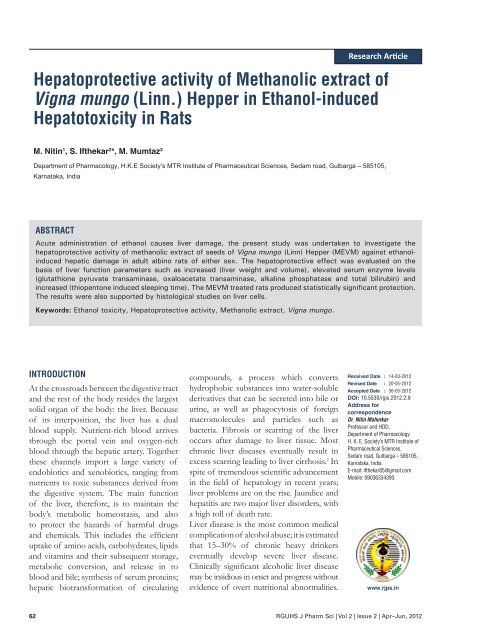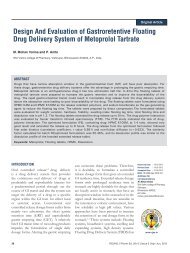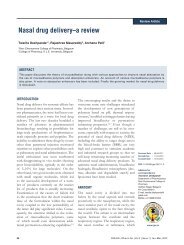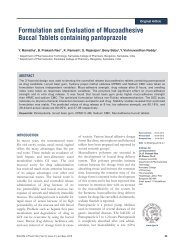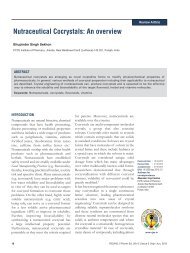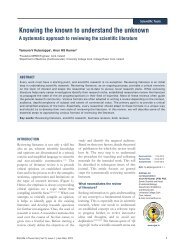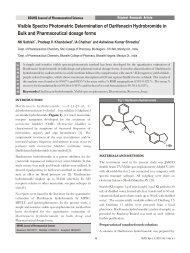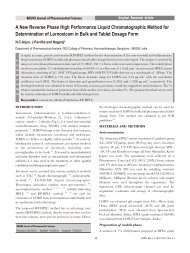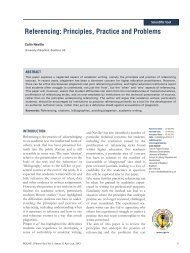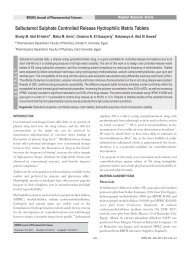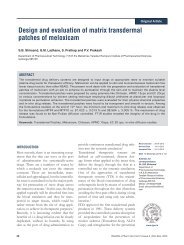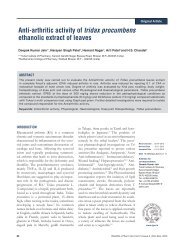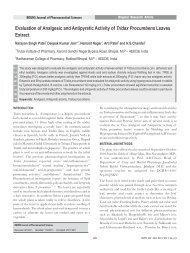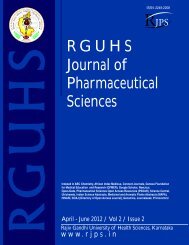RGUHS J Pharm Sci_2_2_09.pdf
RGUHS J Pharm Sci_2_2_09.pdf
RGUHS J Pharm Sci_2_2_09.pdf
Create successful ePaper yourself
Turn your PDF publications into a flip-book with our unique Google optimized e-Paper software.
Hepatoprotective activity of Methanolic extract of<br />
Vigna mungo (Linn.) Hepper in Ethanol-induced<br />
Hepatotoxicity in Rats<br />
M. Nitin 1 , S. Ifthekar 2 *, M. Mumtaz 3<br />
Department of <strong>Pharm</strong>acology, H.K.E Society’s MTR Institute of <strong>Pharm</strong>aceutical <strong>Sci</strong>ences, Sedam road, Gulbarga – 585105,<br />
Karnataka, India<br />
ABSTRACT<br />
Acute administration of ethanol causes liver damage, the present study was undertaken to investigate the<br />
hepatoprotective activity of methanolic extract of seeds of Vigna mungo (Linn) Hepper (MEVM) against ethanolinduced<br />
hepatic damage in adult albino rats of either sex. The hepatoprotective effect was evaluated on the<br />
basis of liver function parameters such as increased (liver weight and volume), elevated serum enzyme levels<br />
(glutathione pyruvate transaminase, oxaloacetate transaminase, alkaline phosphatase and total bilirubin) and<br />
increased (thiopentone induced sleeping time). The MEVM treated rats produced statistically significant protection.<br />
The results were also supported by histological studies on liver cells.<br />
Keywords: Ethanol toxicity, Hepatoprotective activity, Methanolic extract, Vigna mungo.<br />
INTRODUCTION<br />
At the crossroads between the digestive tract<br />
and the rest of the body resides the largest<br />
solid organ of the body: the liver. Because<br />
of its interposition, the liver has a dual<br />
blood supply. Nutrient-rich blood arrives<br />
through the portal vein and oxygen-rich<br />
blood through the hepatic artery. Together<br />
these channels import a large variety of<br />
endobiotics and xenobiotics, ranging from<br />
nutrients to toxic substances derived from<br />
the digestive system. The main function<br />
of the liver, therefore, is to maintain the<br />
body’s metabolic homeostasis, and also<br />
to protect the hazards of harmful drugs<br />
and chemicals. This includes the efficient<br />
uptake of amino acids, carbohydrates, lipids<br />
and vitamins and their subsequent storage,<br />
metabolic conversion, and release in to<br />
blood and bile; synthesis of serum proteins;<br />
hepatic biotransformation of circulating<br />
compounds, a process which converts<br />
hydrophobic substances into water-soluble<br />
derivatives that can be secreted into bile or<br />
urine, as well as phagocytosis of foreign<br />
macromolecules and particles such as<br />
bacteria. Fibrosis or scarring of the liver<br />
occurs after damage to liver tissue. Most<br />
chronic liver diseases eventually result in<br />
excess scarring leading to liver cirrhosis. 1 In<br />
spite of tremendous scientific advancement<br />
in the field of hepatology in recent years;<br />
liver problems are on the rise. Jaundice and<br />
hepatitis are two major liver disorders, with<br />
a high toll of death rate.<br />
Liver disease is the most common medical<br />
complication of alcohol abuse; it is estimated<br />
that 15–30% of chronic heavy drinkers<br />
eventually develop severe liver disease.<br />
Clinically significant alcoholic liver disease<br />
may be insidious in onset and progress without<br />
evidence of overt nutritional abnormalities.<br />
Research Article<br />
Received Date : 14-03-2012<br />
Revised Date : 20-05-2012<br />
Accepted Date : 30-05-2012<br />
DOI: 10.5530/rjps.2012.2.9<br />
Address for<br />
correspondence<br />
Dr. Nitin Mahurkar<br />
Professor and HOD,<br />
Department of <strong>Pharm</strong>acology<br />
H. K. E. Society’s MTR Institute of<br />
<strong>Pharm</strong>aceutical <strong>Sci</strong>ences,<br />
Sedam road, Gulbarga – 585105,<br />
Karnataka, India.<br />
E-mail: ifthekar85@gmail.com<br />
Mobile: 09036334393.<br />
www.rjps.in<br />
62 <strong>RGUHS</strong> J <strong>Pharm</strong> <strong>Sci</strong> | Vol 2 | Issue 2 | Apr–Jun, 2012
Nitin M. et al.: Hepatoprotective activity of Methanolic extract of Vigna mungo (Linn.) Hepper in Ethanol-induced Hepatotoxicity in Rats<br />
Alcoholic fatty liver, a reversible condition, may progress<br />
to alcoholic hepatitis and finally to cirrhosis and<br />
liver failure. In the USA, chronic alcohol abuse is the<br />
leading cause of liver cirrhosis and of the need for liver<br />
transplantation. The risk of developing liver disease is<br />
related both to the average amount of daily consumption<br />
and to the duration of alcohol abuse. Women appear<br />
to be more susceptible to alcohol hepatotoxicity than<br />
men. Another factor that increases the risk of severe<br />
liver disease is concurrent infection with hepatitis B or<br />
C virus. 2<br />
There are only a few synthetic drugs available for the<br />
treatment of hepatic disorders. In allopathic system of<br />
treatment, corticosteroids and immunosuppressants<br />
are commonly used, but these drugs have adverse<br />
effects such as immunosuppression and bone marrow<br />
depression and success rate of treating liver diseases<br />
is low. Silymarin, a flavonoid ligand mixture extracted<br />
from the Silybum marianum (milk thistle) is a popular<br />
remedy for hepatic diseases, however there are several<br />
herbs/herbal formulations claimed to possess beneficial<br />
activity in treating hepatic disorders. 3<br />
Vigna mungo (Linn) Hepper commonly known as Black<br />
gram (Mash, Urid), belongs to family Fabaceae. Vigna mungo<br />
is a diffuse annual herb; stem 30–60 cm long, clothed<br />
with brownish silky hairs. Leaves 3 foliolate; leaflets<br />
5–10 cm long, flowers yellow in axillary racemes, pods<br />
subcylindric; 3.8–6.3 cm long. It is extensively cultivated<br />
all over the India. It has been used for various medicinal<br />
purposes in Ayurvedic and Unani systems of medicine.<br />
The seeds are sweet, laxative, aphrodisiac, tonic,<br />
appetizer, diuretic, galactagogue and styptic; useful in<br />
piles, asthma, scabies, leucoderma, gonorrhea, pains,<br />
epistaxis, paralysis, rheumatism and affections of the<br />
nervous system, liver and cough. It is also prescribed for<br />
dropsy and cephalalgia. 4 Vigna mungo L. (Fabaceae) has<br />
been reported to be used in a variety of disease conditions<br />
of liver in Indian traditional system of medicine. 5<br />
Vigna mungo has been reported for its hepatoprotective<br />
activity against acetaminophen and CCl 4 model, 6<br />
for antioxidant activity, 7 and for its diuretic activity. 8<br />
However, no other models were used for screening<br />
of its hepatoprotective activity. Therefore the present<br />
investigation was undertaken to evaluate the hepatoprotective<br />
activity of Vigna mungo using ethanol model.<br />
MATERIALS AND METHODS<br />
Drugs and chemicals<br />
Silymarin was obtained as a gift sample from Micro<br />
Labs. Bangalore. The kits for the biochemical estimation<br />
were purchased from Pathozyme diagnostics Kagal,<br />
Dist. Kolhapur, India. The ethanol, solvents and other<br />
chemicals were procured from reputed manufacturers.<br />
Preparation of seed extract<br />
The seeds of Vigna mungo (Linn.) Hepper (500 g) were<br />
purchased from the local market of Gulbarga, Karnataka;<br />
were authenticated at <strong>Pharm</strong>acognosy department of<br />
HKES’s MTR Institute of <strong>Pharm</strong>aceutical <strong>Sci</strong>ences,<br />
Gulbarga. The seeds were powdered and defatted with<br />
petroleum ether and then subjected to extraction with<br />
methanol (95%) using Soxhlet apparatus for 18 h. the<br />
extract was concentrated on water bath to obtain thick<br />
pasty mass. The percentage yield was 2.6% w/w.<br />
Phytochemical screening<br />
Preliminary phytochemical screening of Methanolic<br />
extract of seeds of Vigna mungo was carried out as<br />
described by Khandelwal. 9<br />
Experimental animals<br />
The albino rats of either sex (200–250 g) were used for<br />
this study. The rats were housed in polypropylene cages<br />
and maintained under standard conditions (12 h. light<br />
and dark cycles, at 25 ± 5°C and 35 – 60% humidity)<br />
standard pelletised feed and tap water were provided<br />
ad libitum. The animals were acclimatized to laboratory<br />
conditions for 48 hour prior to the experimental protocol<br />
to minimize any nonspecific stress. The Institutional<br />
Animal Ethics Committee of H.K.E.S’s College of<br />
pharmacy, Gulbarga, India, approved the experimental<br />
protocol in accordance with the guidelines provided by<br />
Committee for the Purpose of Control and Supervision<br />
of Experiments on Animals (CPCSEA) with registration<br />
no. 142/1999 CPCSEA 5th July 1999.<br />
Acute toxicity studies<br />
According to earlier reports the dose of Vigna mungo<br />
seed extract 500 mg/kg body weight p.o. was used as<br />
hepatoprotective. 6 As Vigna mungo seeds are used as food<br />
and can be consumed in daily life. The dose selection<br />
was based upon literature review and our studies in<br />
the laboratory. Solanki YB and Jain SM have reported<br />
safety levels of drug and used 500 mg/kg. our laboratory<br />
reports also revealed concurrent values. Hence the above<br />
dose was selected.<br />
Hepatoprotective activity<br />
The albino rats of either sex (200 – 250 g) were selected<br />
and divided into four groups of six animals each.<br />
The treatment protocol is summarized as shown below. 10<br />
Group 1- Normal control: 2% suspension of gum acacia<br />
(1ml/kg) p.o. once daily for 25 days.<br />
Group 2- Ethanol control: Ethanol (3.76 g/kg) twice<br />
daily, p.o. for 25 days.<br />
Group 3- Standard: Silymarin (100 mg/kg) p.o. followed<br />
by ethanol (3.76 g/kg) p.o. after a gap of 30 min for 25 days.<br />
<strong>RGUHS</strong> J <strong>Pharm</strong> <strong>Sci</strong> | Vol 2 | Issue 2 | Apr–Jun, 2012 63
Nitin M. et al.: Hepatoprotective activity of Methanolic extract of Vigna mungo (Linn.) Hepper in Ethanol-induced Hepatotoxicity in Rats<br />
Group 4- Methanolic extract of seeds of Vigna mungo<br />
(500 mg/kg) p.o. followed by ethanol (3.76 g/kg) p.o. after<br />
a gap of 30 min for 25 days.<br />
The study was carried out for 25 days. On 26th day<br />
thiopentone sodium (40 mg/kg, i.p.) was injected and<br />
the sleeping time was recorded. After complete recovery,<br />
the blood samples were collected from all animals by<br />
retro orbital puncture method. Serum was separated<br />
by centrifugation at 2500 rpm for 15 min. and analyzed<br />
for various biochemical parameters such as serum<br />
glutathione pyruvate transaminase (SGPT), oxaloacetate<br />
transaminase (SGOT), alkaline phosphatase (ALP),<br />
and total bilirubin (BIT). Immediately after collection<br />
of blood the animals were euthanized with an over<br />
dosage of ether and sacrificed by cervical dislocation.<br />
The livers were removed, washed in saline and the wet<br />
weight and volume was determined then transferred<br />
into 10% formalin for its histopathological studies. 11<br />
Histopathological studies<br />
Histopathological study of livers was performed in histopathology<br />
Laboratory by consultant histopathologist.<br />
Haematoxylin-eosin was used for staining in histopathology<br />
studies.<br />
Statistical analysis<br />
The data obtained in the experiment was expressed in<br />
terms of mean ± SEM. Statistical significance of data<br />
was assessed by one way analysis of variance (ANOVA)<br />
followed by a comparison between different groups<br />
using “Tukey-Kramer” multiple comparison test. A<br />
value of P
Nitin M. et al.: Hepatoprotective activity of Methanolic extract of Vigna mungo (Linn.) Hepper in Ethanol-induced Hepatotoxicity in Rats<br />
a. Group 1 (Normal control): Showing normal histology<br />
of rat liver.<br />
c. Group 3 (Standard): C&INF- mild Congestion and<br />
inflammation.<br />
b. Group 2 (Ethanol control): CVC-Central vein<br />
congestion, INF-Inflammation.<br />
d. Group 4 (MEVM): RH-Showing regenerating hepatocytes.<br />
Figure 1: Effect of methanolic extract of seeds of Vigna mungo (MEVM) on histopathological examination of rat liver in ethanol-induced<br />
hepatotoxicity.<br />
<strong>RGUHS</strong> J <strong>Pharm</strong> <strong>Sci</strong> | Vol 2 | Issue 2 | Apr–Jun, 2012 65
Nitin M. et al.: Hepatoprotective activity of Methanolic extract of Vigna mungo (Linn.) Hepper in Ethanol-induced Hepatotoxicity in Rats<br />
induced by ethanol. The hepatoprotective effect offered<br />
by methanolic extract of seeds of Vigna mungo was<br />
found to be significantly greater than silymarin treated<br />
group (Table 2).<br />
Hepatocytes of the normal control group showed a<br />
normal histology of the liver. In the ethanol treated<br />
group the liver showed loss of lobular architecture,<br />
extensive central vein dilation, sinusoidal congestion<br />
and inflammation. Silymarin-and MEVM-pretreated<br />
groups showed mild central vein dilation, architecture<br />
of the liver was maintained, and hepatocytes showed<br />
regeneration. (Figure 1)<br />
DISCUSSION<br />
Alcoholic beverages are used universally and alcohol<br />
is the world’s most widely used psychoactive drug,<br />
but chronic, excessive alcohol consumption leads to<br />
permanent organ damage or death. Alcohol is rapidly<br />
oxidized in the liver tissue to acetaldehyde and acetate<br />
by alcohol dehydrogenase (ADH) and acetaldehyde<br />
dehydrogenase (ALDH), respectively. 12 Recent study<br />
indicates that oxidative stress is involved in the<br />
pathogenesis of liver diseases including drug induced<br />
hepatic damage, alcohol hepatitis and viral hepatitis<br />
or ischaemic liver injury. 13 Increased formation of<br />
lipoperoxides, conjugated dienes and malondialdehyde<br />
and reduced levels of antioxidants like vitamin E and<br />
glutathione in the tissues have been demonstrated in<br />
experimental animals administered with ethanol as well<br />
as in alcoholic human subjects. The increased level of<br />
SGPT, SGOT, ALP, and total bilirubin is conventional<br />
indicator of liver injury. 14 Oxidative stress is one major<br />
factor in etiology of ethanol injury, mainly by Kupffer<br />
cell derived reactive oxygen species (ROS), ethanol<br />
activates Kupffer cells primarily through the action of a<br />
substance called endotoxin, which is released by certain<br />
gram-negative bacteria present in the intestine, which<br />
generates ROS and pro inflammatory cytokines (TNF<br />
alpha, IL 1) and both of them can lead to liver damage. 15<br />
The hepatic injury leads to elevation of serum levels of<br />
SGPT (ALT), SGOT (AST), ALP, and BIT in rats and<br />
are used as markers for assessing toxicant effect and also<br />
hepatoprotective agents. During hepatic damage these<br />
enzymes present in the liver cells leak into the serum,<br />
resulting in increased concentrations. 16<br />
In the present study ethanol administration for 25 days<br />
resulted in morphological changes such as enlargement<br />
of liver, scratches, dark brown coloration and increased<br />
volume. Barbiturates are a class of xenobiotics that<br />
are extensively metabolized in the liver. Deranged liver<br />
function leads to delay in the clearance of barbiturates,<br />
resulting in a longer duration of hypnotic effect. 17 In the<br />
present study, administration of thiopentone sodium to<br />
rats treated with ethanol resulted in an increased duration<br />
of thiopentone-induced sleeping time. Whereas the<br />
Vigna mungo seed extract (MEVM) pretreated animals<br />
showed similar morphology of livers compared to that of<br />
normal control animals that were healthy in appearance<br />
and significantly decreased the weight and volume, and<br />
also showed decreased thiopentone-induced sleeping<br />
time, an indirect evidence of their hepatoprotective<br />
effect.<br />
Ethanol administration also produces significantly<br />
increased serum marker enzymes such as SGPT, SGOT,<br />
ALP and BIT in ethanol control group compared<br />
to normal control group. Treatment with MEVM<br />
significantly decreased the enzymes SGPT, SGOT, ALP<br />
and BIT levels as compared to ethanol control group. All<br />
the above parameters indicating their hepatoprotective<br />
effect against ethanol-induced liver cell damage.<br />
Histological changes such as loss of lobular architecture,<br />
extensive central vein dilation, sinusoidal congestion and<br />
inflammation were observed in ethanol control group.<br />
The Vigna mungo seed extract (MEVM) pretreated animals<br />
had significantly prevented these histological changes,<br />
further indicating their hepatoprotective activity. All the<br />
histological changes observed were in correlation with<br />
the physical, biochemical and functional parameters of<br />
the liver.<br />
Ethanol is metabolized largely by sequential hepatic<br />
oxidation, first to acetaldehyde and then to acetic acid. 18<br />
Acetaldehyde is thought to have a number of adverse<br />
effects like decreased transport and secretion of proteins<br />
owing to tubulin polymerization, enhanced vitamin<br />
metabolism and trace metals. Drugs like paracetamol<br />
cause severe acute liver injury which is sometimes<br />
fatal. 19,20,21 Antioxidants exhibit hepatoprotective activity<br />
by blocking the conversion of ethanol to acetaldehyde. 22<br />
Liver diseases are often associated with edema and ascites<br />
in conjunction with elevated portal hydrostatic pressure<br />
and reduced plasma oncotic pressure, the mechanisms<br />
for retention of sodium by the kidney are complex, they<br />
probably involve a combination of factors, including<br />
diminished renal perfusion resulting from systemic<br />
vascular alteration, diminished plasma volume as a result<br />
of ascites formation and diminished oncotic pressure<br />
due to hypoalbuminemia. In addition, there may be<br />
primary sodium retention by the kidneys and diuretic<br />
therapy is useful to overcome the ascites and edema. 2<br />
From the previous studies it was found that Vigna mungo<br />
has exhibited diuretic activity, 8 due to the presence of<br />
strong antioxidants like ascorbic acid, total phenolic<br />
compounds, tannins, flavonoids etc. The presence of<br />
potent diuretic such as saponins in the extract may be<br />
responsible for the hepatoprotective activity.<br />
The earlier reports carried out with the extract of<br />
Vigna mungo in acetaminophen and CCl 4 model have<br />
66 <strong>RGUHS</strong> J <strong>Pharm</strong> <strong>Sci</strong> | Vol 2 | Issue 2 | Apr–Jun, 2012
Nitin M. et al.: Hepatoprotective activity of Methanolic extract of Vigna mungo (Linn.) Hepper in Ethanol-induced Hepatotoxicity in Rats<br />
shown SGPT, SGOT, ALP and BIT values 99.33, 121.17,<br />
59.067 and 1.84 IU/L. The present studies using ethanol<br />
model have shown SGPT, SGOT, ALP, and BIT values<br />
49.61, 74.51, 147.18, and 0.76 IU/L. levels respectively<br />
indicating a greater level of protection in this model.<br />
CONCLUSION<br />
From the above studies it can be concluded that<br />
methanolic extract of seeds of Vigna mungo (Linn.)<br />
Hepper (MEVM) possesses a hepatoprotective activity<br />
against ethanol-induced hepatotoxicity.<br />
ACKNOWLEDGEMENT<br />
The authors are thankful to authorities of H.K.E.S’s<br />
MTR Institute of pharmaceutical <strong>Sci</strong>ence, Gulbarga for<br />
providing the necessary facilities to carryout the work.<br />
REFERENCE<br />
1. Grietje Molema and Dirk Meijer KF. Drug targeting organ-specific<br />
strategies. Germany: Wiley-VSH Verlag Gmbh; 2001.<br />
2. Bertram Katzung G, Susan B and Anthony J. Basic and clinical<br />
pharmacology 9th ed. New Delhi: Tata McGraw-Hill Edition Pvt Ltd;<br />
2004.<br />
3. Ramachandra SS, Absar AQ, Viswanath Swamy AH et al.<br />
Hepatoprotective activity of Calotropis procera flowers against<br />
paracetamol-induced hepatic injury in rats. Fitoterapia 2007;8:451–454.<br />
4. Kirtikar KR and Basu BD. Indian Medicinal plants. Dehradun:<br />
International Book Distributors;1993(1):795–796.<br />
5. Anonymous. The Ayurvedic Formulary of India. Part-I. New Delhi:<br />
Government of India, Ministry of Health and Family Welfare, Department<br />
of Indian Systems of Medicine and Homeopathy; 2003.<br />
6. Solanki YB, Jain SM. Hepatoprotective activity of Clitoria ternatea and<br />
Vigna mungo against Acetaminophen and CCl 4 -induced hepatotoxicity<br />
in rats. Journal of pharmacol and Toxi 2011;6(1):30–48.<br />
7. Manisha chikane R, Dilip parwate V, Vishwas ingle N et al. In vitro,<br />
Antioxidant effect of seed coat extracts of Vigna mungo. Journal of<br />
pharmacy Research 2011;4(3):656–657.<br />
8. Chowdhurry AKA, Jahioullah IJ, Tabukder SA, Khan AKA. Diuretic<br />
activities of saponins of Vigna spp. J Bangladesh Acad <strong>Sci</strong> 1987;<br />
11:75.<br />
9. Khandelwal KR. Practical pharmacognosy technique and experiments.<br />
9th ed. Pune: Nirali Prakashan; 2000.<br />
10. Shukla V, Tiwari RK and Agarwal DP. Hepatoprotective role of Picroliv<br />
isolated from Pocrorhiza kurroa on alcoholic-induced liver necrosis. Adv<br />
<strong>Pharm</strong>acol Toxicol 2001;2:9–16.<br />
11. Shyamladevi CS and Devipriya S. Liver diseases are a large public<br />
healthy problem in the world. Indian J <strong>Pharm</strong>acol 1999;31:422–426.<br />
12. Lieber CS. Alcohol and the liver: Metabolism of ethanol, metabolic<br />
effects and pathogenesis of injury. Acta Med Scand Suppl 1985;703:<br />
11–55.<br />
13. Gutteridge JMC. Free radicals in disease processes: a complication of<br />
cause and consequence. Free Radical Research 1993;19:141–158.<br />
14. Zhen-Ming Lu, Wen-Yi Tao, Xi-Liang Zou, Hui-Zi Fu, Zong-Hua Ao.<br />
Protective effects of mycelia of Antrodia camphorata and Armillariella<br />
tabescens in submerged culture against ethanol-induced hepatic<br />
toxicity in rats. J Ethnopharmacol 2007;110:160–164.<br />
15. Pornpen Pramyothin, Patcharavadee Samosorn, Somlak Poungshompoo,<br />
Chaiyo Chaichantipyuth. The protective effects of Phyllanthus<br />
emblica Linn. Extract on ethanol induced rat hepatic injury.<br />
J Ethnopharmacol 2006;107:361–364.<br />
16. Deb AC. Fundamentals of Biochemistry. 17th ed. Kolkata: New Central<br />
Book Agency; 1998.<br />
17. Kulkarni SK. Hand book of experimental pharmacology. 3rd ed.<br />
New Delhi: Vallabh Prakashan; 1999.<br />
18. Goodman and Gilman’s. The <strong>Pharm</strong>acological Basis of Therapeutics.<br />
11th ed. New Delhi: McGraw-Hill Companies; 2009.<br />
19. Frumenty B, Pessayre D. Impaired mitochondrial function in<br />
microvesicular steatosis. Effect of drugs, ethanol, hormones and<br />
cytokines. J Hepatol 1997;26:43–53.<br />
20. McClain CJ, Kromhount JP. Potentiation of acetaminophen hepatotoxicity<br />
by alcohol. JAMA 1980;244:251–253.<br />
21. Seeff LB, Adler E. Acetaminophen hepatotoxicity in alcoholics.<br />
A therapeutic misadventure. Ann Int Med 1986;104:399–404.<br />
22. Maneesh M, Jayalakshmi H. Effect of ascorbic acid, alpha<br />
tocopherol, lecithin and L-ornithine-L-aspartate on ethanol induced<br />
hypoproteinemia and hyperlipidaemia in rats. Indian J Physiol <strong>Pharm</strong>acol<br />
2005;49:422–426.<br />
<strong>RGUHS</strong> J <strong>Pharm</strong> <strong>Sci</strong> | Vol 2 | Issue 2 | Apr–Jun, 2012 67


